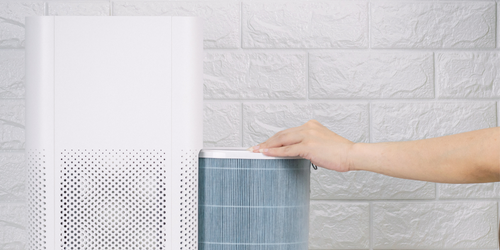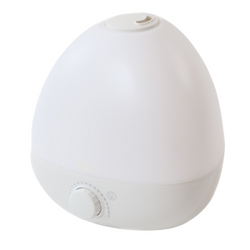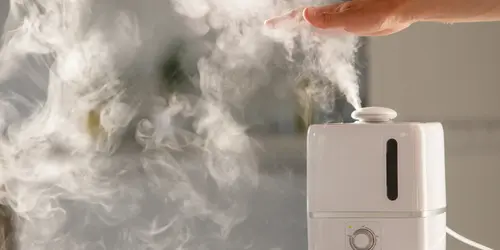How to clean mold out of Frida humidifier
Cleaning mold out of a humidifier requires time and effort. However, keeping the humidifier clean is important to protect the quality of mist being spread into the room add moisture to the dry air and improve the humidity levels of the room.
In this article, we will discuss in detail the step-by-step cleaning process to clean your humidifier. Cleaning your Frida humidifier can be done effortlessly by following these simple steps and the precautions to prevent mold from growing in your unit.
What does mold in a humidifier look like?
Mold growth in the humidifier is a health hazard. Breathing in air that has been affected with mild is going to pave way for several respiratory health problems. The humidifier mold problem must be resolved at the earliest. You can clean mold growth from humidifiers with ease using just a few products and simple steps which we will be discussing later on in the article. You can also follow measures to prevent mold growth in your humidifier.
Identifying humidifier mold is easy. Take a close look at the water tank, the surface water in the tank, and the inner walls of the water tank. If you notice green mounds in the corners, black specks on the walls, or a slimy film on the surface it is a clear indication that is high time you clean your humidifier. Keeping your humidifier clean must be a priority to keep the air free from mold spores. You must remember that breathing in clean air is more crucial than breathing in dry air.
Is it safe to use a humidifier that has mold?
No. It is hazardous to one’s health to use humidifiers that have mold in them. You must always make sure you run the humidifier only when it has clean water in it. If you notice any visible signs of mold growing anywhere in humidifiers, you must clean them immediately to stop the growth of bacteria, mold, or any other contaminant.
How to clean Frida humidifier? – A Step By Step Guide

Your Frida humidifier will come with clear instructions in the user manual on how often the humidifier parts have to be cleaned and the procedure for regular maintenance. Here we have the step-by-step guide for cleaning mold and other contaminants from a Frida humidifier.
Let us take a look at the simple cleaning process to keep your Frida humidifier clean and free from mold growth. Bear in mind that you must make the best use of protective gear before you deal with any type of cleaning solution. Wear gloves, goggles, and a face mask while you carry out the cleaning in a well-ventilated area.
Begin the process by emptying the water tank and reservoir from all the water. You can empty this contaminated water containing bacteria, mold, and other allergens and simply flush it down the toilet. Be prepared that the disinfecting process can take anywhere between 30 minutes up to an hour depending on the level of mold growth in the machine.
Step 1- Sanitization

To sanitize the humidifier in cases of extensive mold, you can fill the water reservoir with a hydrogen peroxide solution, making sure all the areas with mold have been covered. Using the hydrogen peroxide solution directly from the bottle will be ideal in this case. You can also soak the removable plastic parts and other humidifier parts in the hydrogen peroxide solution. Remember, this applies only to plastic parts and not to the filters or humidifier parts that have electrical supply points to them.
Sanitizing the humidifier can also be done using distilled white vinegar. This is a readily available and trusted agent to clean mold. You can begin by pouring one part water and one distilled white vinegar into the reservoir and letting it rest for a few minutes. Allowing the solution mixture to rest is good to get rid of mold and build-up from minerals that are present in tap water.
If the mold is minimal on the reservoir or water tank, you can simply fill a spray bottle with the hydrogen peroxide solution and apply it to the humidifier parts and plastic parts. In cases where you do not find any visible mold, take a clean cloth with the hydrogen peroxide solution and wipe down the exteriors, all parts, and the water tank or reservoir.
As a cautionary word, you must always remember to avoid harsh chemicals while disinfecting the machine. This can lead o serious lung health problems and damage the machine as well.
Step 2: Scrubbing

Using a scrub brush to remove stubborn mold is helpful. You can make use of any soft bristle brush or toothbrush as a scrub brush. For better abrasion, you can form a mixture or paste using a small quantity of baking soda with a hydrogen peroxide solution. Take a little amount of the mixture on the soft bristle brush and scrub the mold area until it disappears completely.
If the mold stains are stubborn, you can let the hydrogen peroxide solution and baking soda mixture sit for 10 minutes and then wipe them off.
Step 3: Rinsing

Rinsing the reservoir and the cleaned parts must be done a couple of times. You can flush the cloudy and mold-filled water down the toilet. It is suggested that you rinse again with clean water or tap water a few times. As for the final rinse, you can use distilled water.
Drain the distilled water completely and air dry the humidifier thoroughly before you pour the clean water back into the unit.
How often should you clean Frida humidifier?

The frequency with which you must clean your humidifier to keep it free from mold will be mentioned in the instruction manual that comes along with the model or unit your purchase. The recommended cleaning routine by the experts suggests that regular maintenance is a must to keep the mist from being contaminated with mold and bacteria.
Allowing any moisture or water to rest in the reservoir or water tank while being put into storage or when not in use is going to create the perfect environment for mold and bacteria to thrive. If you plan to store for any season, be it winter or a week, or even a night without use; remember to always flush the water out and give a quick rinse with distilled water or distilled white vinegar before refilling with clean water.
Although you might not be seeing any visible mold, several invisible mold spores or bacteria can still be present in the stagnant water that you permit to rest for the night or the week. Moisture and water are a sponge to microorganisms that create the home for diseases within the unit therefore all parts of the humidifier must be kept dry when not in use, especially while storing them.
We suggest you remember that the U.S. EPA strongly recommends that you deep clean your humidifier every three days. We would like to re-empahsise the caution on avoiding any harful cheamical solution like bleach solution or mixing vinegar with hydrogen peroxide. You must mix hydrogen peroxide with one part water and not with vinegar. This will create a toxic peracetic acid which is hazardous.
How to prevent humidifier mold?

You can certainly prevent mold from growing in your humidifier unit with a consistent and efficient cleaning routine. A proper cleaning routine for any unit is going to guarantee durability and better performance. By cleaning your humidifier regularly, you will not just prevent humidifier mold but will also be able to add moisture and humidity to the room effectively. The dry air can be replaced with healthy and clean mist, that is free from mold and bacteria. Clean your humidifier with the goal to improve the quality of mist and stay away from health problems.
Here are a few points to recall when it comes to keeping the humidifier safe from mold.
- Pour the stagnant or used water out of the water tank or reservoir before you fill the reservoir with clean water.
- All materials that you use for the cleaning process must also be cleaned priority; use a clean cloth, clean scrub brush or gentle bristle brush, hygienic cleaning products, etc.
- Carry out the cleaning process in a well-ventilated area to make sure the contaminants do not circulate within the room.
- Replace filters as and when required, especially if the filter has been contaminated with extensive mold.
- Refrain from using any harsh cleaning solution. This will damage the quality of the unit, and the filter, and also affect one’s lung health. Do not use any type of bleach solution for the reservoir or the filter.
- Replace using tap water with demineralized water. Tap water which is hard will carry large amounts of minerals in this. Minerals that have not been removed from hard tap water will create sediments in the area around the humidifier and the mist as well. demineralized water or distilled water that is free from minerals will protect the quality of the mist and keep the humidifier clean.
FAQ Section
1. How to clean pink mold from humidifier?
Removing pink mold from humidifiers is the same as cleaning any other type of mold. To clean your humidifier of the pink mold growing in it you can use hydrogen peroxide solution or one part water with white vinegar. You can follow the same cleaning routine as suggested previously in the article.
2. Why is your baby Frida humidifier blinking blue?
Is your Frida baby humidifier blinking blue? This indicates that the water tank is low on water. You simply have to unplug the unit and fill the tank with water to resolve the issue.
Blue light can also indicate a loose connection between the base and the tank. You have to attach the tank firmly to the base to resolve the error.
It is advised to check the user manual to understand what each error code indicates, as it may vary across models. Reach out to customer support if you are unable to resolve the error with the manual’s assistance.
3. How to reset Frida humidifier?
To reset the Frida humidifier, you can fill the tank with clean water and leave it tuned On for 5 hours on a hard surface.
4. Does Frida humidifier need distilled water?
It is strongly recommended that you use filtered water or distilled water in humidifiers. This will ensure enhanced performance and prevent the formation of residue from minerals.
5. What to add to humidifier water to prevent mold?
To prevent mold from forming in your humidifiers, you can add white vinegar to the water in the reservoir, allowing it to soak for 10 minutes, and then clean the unit. This will create an environment that hinders mold and bacteria.
6. Can humidifier cause mold on walls?
Humidifiers can cause mold on walls if their moisture addition to the room is not monitored. Adding excessive mist to the room and raising the humidity levels beyond the ideal levels can lead to mold formation on walls, ceilings, and other surfaces.
Wrapping Up
That’s a wrap on the article. We trust you learned how to clean mold from a Frida humidifier. Set a consistent cleaning routine for your humidifiers to prevent mold from growing in your humidifiers. Clean the humidifiers as suggested by experts to protect the unit and your health and enjoy the comfort of a balanced humidity level in your space.

About The Author
Olivia — a self-confessed air quality addict — is a home climate enthusiast, fresh air advocate, and someone with deep personal experience and knowledge about mold extermination. Her work was mentioned in countless notable humidity publications. Previously she was an editor at Mold Remediation.

